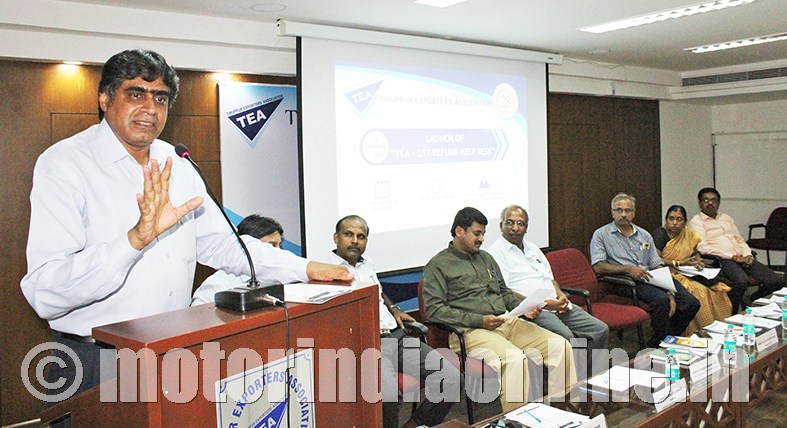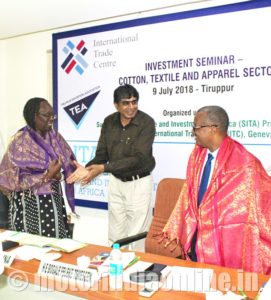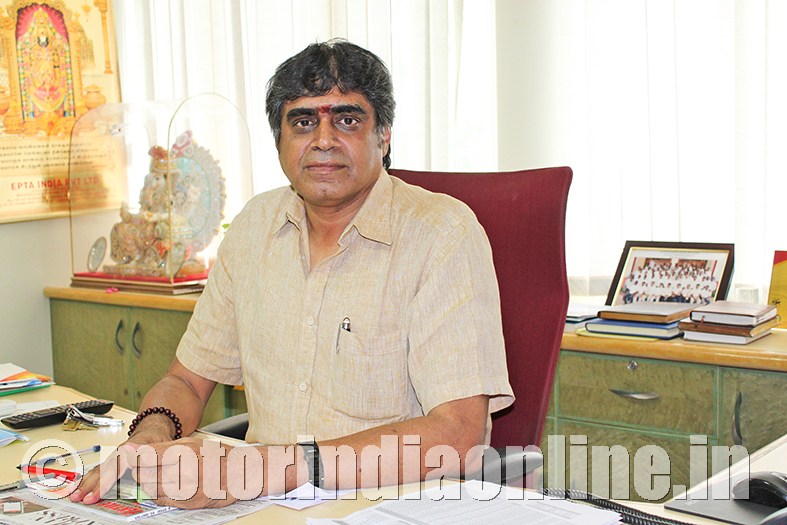Tiruppur has its special role in the Indian textile industry’s growth story. It is a city that is characterized by the sheer dynamism and the can-do spirit of its entrepreneurs who have made it big against all odds. A city spread across hardly 6 square kilometres which accounts for around 50% of the country’s apparel exports. Today Tiruppur has earned the reputation of being one of the most important knitwear and apparel manufacturing hubs in the world.
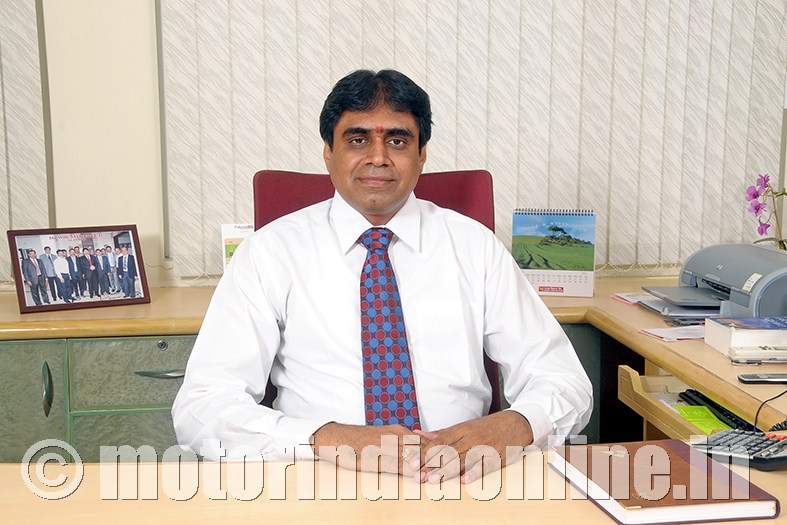
It has been a story of resilience, with the entrepreneurs in the city overcoming several challenges over the years, ranging from currency fluctuations and closure of units due to the environmental issue to the demonetization and the teething troubles after the GST roll-out. Throw them a challenge and it is most likely that they would surmount it. Their ability to work hard, being open minded to accept new technologies and daring to dream big has seen some of the most heartwarming success stories, where scores of entrepreneurs have risen from their humble beginnings to make it big in the export markets.
Much of Tiruppur’s success as a textile hub is due to the role played by the members of the Tiruppur Exporters’ Association (TEA), who have worked tirelessly towards the welfare and growth of all the member-companies and the overall industry. The cluster has been fortunate to have visionary leadership over the last three decades providing the much-needed guidance and support.
One such visionary leader who is steering Tiruppur through a very challenging phase is Mr. Raja M. Shanmugham. From the time he took over as the President of TEA, about two years ago, he has been facing a series of challenges such as sluggish demand in key global markets and certain disruptive reform initiatives such as demonetization and GST. Tactfully guiding the association through choppy waters, he is most optimistic about its revival.
In an exclusive chat, Mr. Raja Shanmugham spoke at length about the recent industry trends, the impact of policy initiatives, the key achievements of TEA after took over, experimentation with new products development, pollution-related issues and future growth prospects, among others.
The edited excerpts:
It has been nearly two years since Mr. Raja Shanmugham took over the reins of TEA. It has been a period marked with numerous challenges. Elaborating on them, Mr. Raja Shanmugham said: “There have been challenges due to the macro-economic changes like demonetization, GST roll-out, Brexit, etc. All these happened in quick succession and that is what made the challenges more difficult to face. However, I am happy to state that we have been able to surmount them”.
Mr. Raja Shanmugham also runs his own textile company, Warsaw International, which was started by him along with his brother in 1989. Today he is shouldering a huge responsibility of promoting and safeguarding the interests of hundreds of textile companies and lakhs of people working in the Tiruppur knitwear and apparel industry. Warsaw International, along with its group companies, has its presence along the entire textile value chain, from spinning to garmenting. The group has also diversified into renewable energy and a fully integrated composite unit for coconut-based products.
Ever-growing industry
Textiles is a sunrise industry enjoying ever-growing demand. Despite severe competition from markets like China, Bangladesh, Vietnam and Cambodia, Tiruppur continues to be one of the most preferred destinations for global brands for sourcing knitwear apparels and garments. Continuous improvement in quality, adherence to the environment and safety norms and prompt on-time deliveries have been their key strengths.
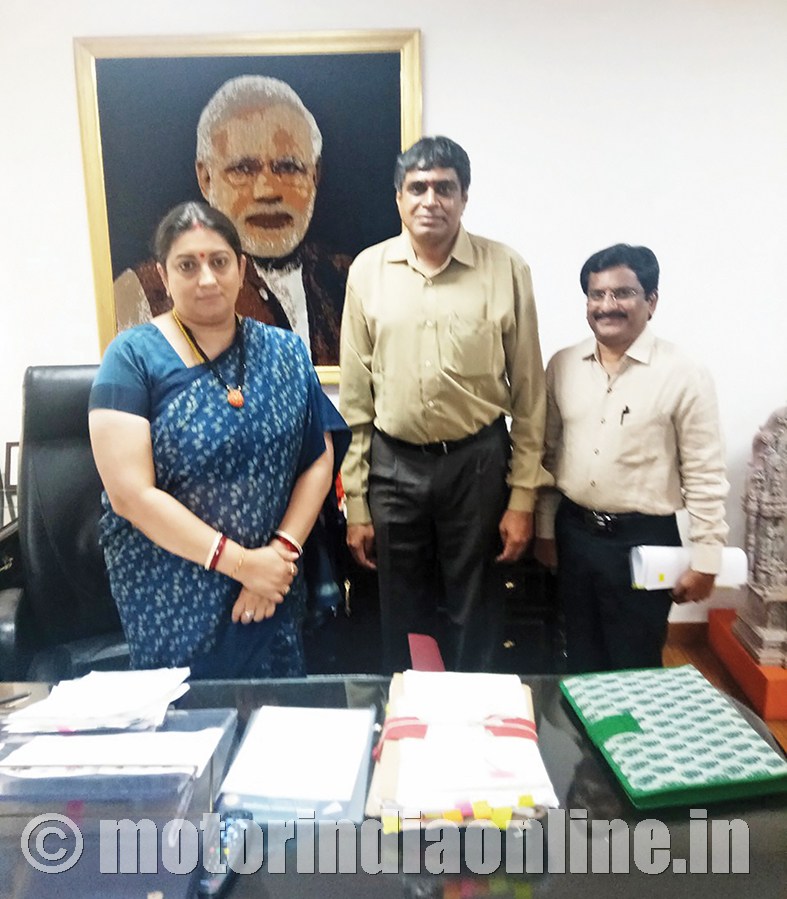
Mr. Raja Shanmugham has been regularly interacting with various ministries and highlighting the advantages of the cluster and the support required to help Tiruppur leap to the next level of growth. Going into details, he said: “I have explained the concerns to the various ministries such as Textiles, Commerce and MSME and to a certain extent Finance also. On all the occasions I have explained the potential of this industry and how it is to be understood so that policies could be formulated accordingly, as well as how this industry benefits lakhs of workers, thousands of budding entrepreneurs and several organizations.”
The TEA President has also emphasized that the industry makes its due rightful demand based on the sustenance factor. “We are in the international race. In such a race, a level playing field has to be ensured, because countries like Bangladesh, Vietnam, Cambodia, etc., have either free trade agreements (FTAs) or the underdeveloped nation tag. In both the cases, they have the advantage of 10% of import tariff. This places us at a disadvantage. Now, this is an unfair race,” he said.
Referring to two key factors, namely, India being the largest cotton producing country in the world and home to the largest young population globally, he stated that the Government should support the industry to reach its potential and formulate policy initiatives to take advantage of these features.
Mr. Raja Shanmugham felt that we should take a cue from what China has done to its textile industry. He said: “They too are a large cotton producing country. They too have a huge population. They too have the same ecosystem, put forward so beautifully by Prime Minister Modiji, i.e., farm, fiber, fabric, fashion and foreign. They have attained global leadership in readymade garments, without any FTAs. How is it possible? It is because they have created the necessary infrastructure to grow the industry. They are making sure that there is no interruption in supply of raw materials by procuring cotton from India and America. We need to take a cue from them.”
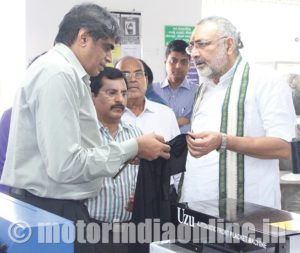
Asked whether there are too many voices within the textile industry representing their concerns to the Government, from fiber producers to spinners to fabric and finished manufacturers, and whether there is the possibility of all these stake-holders coming together in one single platform, he replied: “After I took over the reins of TEA, we have been making conscious efforts for cordial relations among different trade associations. We need to understand everybody’s market compulsions. Once we understand their compulsions, we won’t blame anyone. Cordial relations among all will ensure smooth supply of raw materials to all the segments. We have even made joint presentations with other trade associations to ministries to tell them that they need to focus on getting value additions rather than focus only on raw cotton exports.”
Achievements
Speaking about some of the key achievements in the last few years, Mr. Raja Shanmugham observed: “The cluster accounts for around 50% of the total apparel production in the country. It is a cluster that has blossomed on its own organic strength. During my meeting with the Textile Secretary, that even though there have been special skill training programs developed for such clusters, they have not been conducted in Tiruppur so far. Now we have the skill development facility in NIFT-TEA. This is a major milestone for Tiruppur. We have trained 15,000 people. Now they have come out with revised norms under which we will be training 25,000 more this year.”
“This cluster attracts manpower from different regions, from Assam to Kanyakumari. All south-bound trains offload around 400 fresh job seekers on an average every time they pass through this city. If they had not been trained and provided jobs here they would have been slogging doing menial work. “With this facility, however, they get trained in a matter of just 45 days, and during that time too they are paid a stipend. Plus, they get a skill which would fetch them a livelihood for their entire lifetime. At least another one lakh trained people are required within the Tiruppur cluster itself”, he added.
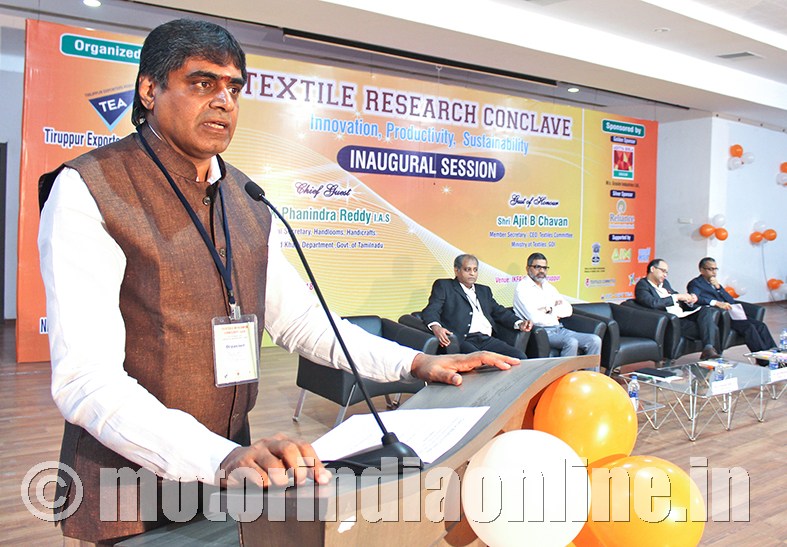
The TEA President further said that Government is providing a grant of Rs. 10,000 per candidate under the initiative, and that it is a win-win situation for everyone, i.e., the entrepreneurs, the candidates and the Government. The trained candidates are absorbed by the member-companies of TEA. The training is being carried out in over 100 member-companies premises in the vicinity, under the aegis of NIFT-TEA, apart from the NIFT-TEA premises itself.
Listing another key achievement, Mr. Raja Shanmugham pointed out to establishment of the Atal Incubation Centre, again under NIFT-TEA. “When applications were called out, I initiated NIFT-TEA to apply. Totally 3,615 applications were received. After the initial screening process, about 100 odds remained. I am proud to state that out of that only NIFT-TEA was selected with a grant of Rs. 10 crores”.
Giving more details about the facility, he said: “This is a creative, design-driven industry. Fashion tends to get obsolete in quick time. We need to be on our toes. Entrepreneurs can come to this incubation platform and try making their conceptualized idea into reality, after which they can commercialize it. With this facility in place, even small entrepreneurs need not worry about investing. They can bring everything here. We want this cluster to make headway in developing man-made products, and this facility is surely going to help. We will be getting all the modern machinery in place in another 3-4 months”.
Potential for man made fibers
Tiruppur is a 100% cotton apparel market. But, with increasing price fluctuations in cotton and the resulting increase in yarn prices, manufacturers are seriously considering other options, including polyster and viscose. Speaking about the potential that man-made fibers hold for entrepreneurs in Tiruppur, Mr. Raja Shanmugham said that the current usage is below 10%.
“70% of the world market’s readymade garments are made up of man-made fibers. Only 30% is made up of cotton. We have been able to tap the 30% market only. With the entire world moving towards man-made fibers, it is time that our entrepreneurs too begin to tap the huge potential there”, he said.
It is in this context that Grasim Industries, with its brand Liva, part of the Aditya Birla Group, has recently inaugurated a LAPF studio to work closely with companies in Tiruppur in helping them make a start by producing viscose-based apparels.
Mr. Raja Shanmugham said: “Our vision in TEA has always been to work towards excellence in buyer engagement, infrastructure and product innovation through collaboration. In this direction we see the LAPF Studio as a platform for fuelling business growth for the Tiruppur cluster. We look forward for innovations in fabric and Liva seasonal collection”.
The result is a world-class design studio in Tiruppur. Entrepreneurs can come and learn or test man-made fibers. There are experts here from whom they can learn. We can also bring buyers here and tell them that we have this facility and that we can handle man-made fabrics efficiently. In fact, with the facility in place, convincing buyers will become that much easier”, he added.
With respect to polyester-based fabrics, Mr. Raja Shanmugham said that Reliance had already invested in a design studio in the neighbouring Coimbatore.” But I have asked them to come to NIFT-TEA, which is also under consideration. We are also exploring creations in wool. We all think that wool is only for winterwear. But now wool has taken different dimensions. It has emerged as a season-neutral product. It is being widely used in intimate wear, and I am sure that it is only a matter of time before our entrepreneurs come out with such products.”
He is sure that entrepreneurs in the city would accept new changes in raw materials and technology. He said: “Our entrepreneurs have a proven track record in embracing new technology. They understand that we have a lot of catching up to be done and that too in quick time. I visualize that after a short initial period where some teething troubles could happen, the switching over process would be relatively smooth here.”
Mr. Raja Shanmugham also stated that another modern design studio is being set up in NIFT-TEA, with the support of the Union MSME Ministry, which has granted Rs. 15 crores for setting up the facility. “Anyone can come out with design ideas and try out different products. We can throw open the facility to international buyers too. For them hiring the services of designers is an expensive proposition. They could instruct designers here and get designs done economically. Since the design is being done in our platform, they will obviously place orders too with our entrepreneurs”, he said highlighting the strategic business advantage that the facility will offer. The facility is expected to be fully operational in about a year’s time.
Resilient Tiruppur
Mr. Raja Shanmugham sounded confident that the apparel industry would tide over what he termed temporary setbacks. He mentioned how Tiruppur’s entrepreneurial resilience has helped them a lot. “TEA was established in 1990, and by 2011 we were able to achieve Rs. 10,500 crores worth of exports and around Rs. 3,500 crores worth of domestic sales. At that point of time came the bolt from the blue. Many dyeing units were closed due pollution. Almost every section was against us. Our morale had hit the rock bottom. That is when the resilient nature of Tiruppur came to our rescue,” he added.
“To rebuild Tiruppur from such a severe setback and to boost the morale of its members, TEA started an initiative called ‘Resilient Tiruppur’ in 2012. That was the turning point. In the next four-and-a-half years, till 2017, we attained an export figure of Rs. 26,000 crores and domestic sales of Rs. 18,000 crores. Tiruppur had risen from the ashes like the proverbial Phoenix.”
Mr. Raja Shanmugham further said that it was after the program that it was decided to bring in the Zero Liquid Discharge (ZLD) technology into play. As part of the initiative there are 18 central effluent treatment plants (CETPs) and 100 independent effluent treatment plants (IETPs) functioning in the cluster now.
He observed: “We are proud to state that we are the only cluster across the globe adhering to ZLD, where, apart from addressing an environmental issue, we are also conserving water to the extent of 15 crore litres per day. Cherapunji may miss a day without rain. However, Tiruppur will not miss a day when this 15 crore litre per day target is not met. Around 92-95% of the water is recycled using multiple stage R.O. system. The remaining 5% or so is subjected to multiple evaporator, wherein the vapor is condensed and water is recovered. The remaining sludge is being sold to cement factories”.
Adding further on the issue Mr. Raja Shanmugham said: “In a single stroke we had silenced the critics. The polluting city tag is now history. We also have an organization called ‘Vanathukul Tiruppur’. Under this program, we have planted 5,25,000 saplings around this cluster. There are 40 tractors for maintaining this green belt”.
Pointing out to another green initiative the TEA President said: “The Tiruppur cluster requires 200 megawatts of power a day. The entire district requires 600 megawatts a day. Tiruppurians have installed 1600 megawatts of green energy in the form of wind and solar farms, which are connected to the grid. We are proud to state that we have a carbon negative footprint”.
China’s backdoor entry strategy
Of late Tiruppur has been facing stiff competition from countries such as Bangladesh, Vietnam and Cambodia which have eaten into its export market. How is Tiruppur surviving? Given the choice of all these nations, why should a buyer choose Tiruppur? He felt, it was the back door entry strategy of Chinese firms into these markets that was hurting exports from Tiruppur.
Commenting on the question he said: “There is a looming threat. I will tell you how China is prepared and how we are ill prepared. China has seemingly been projecting an image that they are reducing their presence in textiles and that they are focusing on equipping their workforce for the next leap, to other aspirational fields such as IT, electronic gadgets, products, etc. But this is not true. What they have done is to retain the core manufacturing ability with them and fanned out other garmenting activities to places like Bangladesh, Vietnam, Cambodia, Myanmar and Sri Lanka, all bordering India. These are all labour-rich poor nations needing investments and job creation. China has therefore, made huge investments in these nations. Now these nations have FTAs, under-developed-nation tags, duty-free access, etc., which give them easy access to markets like Europe and Americas. This is being utilized by China. India has had trade relations with most of these countries as part of SAARC and other agreements. We could enter their market and similarly they could enter ours. Chinese enterprises have camouflaged themselves as Vietnamese or Bangladeshi firms and flooded the Indian and other markets with their products. This becomes a double whammy for India. So, although they pretend as if they have reduced their textile production, they are actually increasing their share in the international markets using this strategy”.
He added: “So, they have used our ill preparedness for their advantage. Just imagine the kind of business we would have had we entered these markets. I had brought this factor to the notice of the Union Textile Minister, stating that this is an economic threat now which could potentially become a sovereign threat later on”.
Positive about growth
Mr. Raja Shanmugham disclosed that despite all the challenges Tiruppur is braving the odds, thanks to its superior sustainability quotient, and that top brands are sourcing from here since they want to show that they are dealing with a cluster that practices environment-friendly manufacturing processes. In the same breath, he added: “But Tiruppur also needs to be protected by Government policies. Otherwise these advantages could also vanish”.
“We have set our vision of touching the Rs. 1,00,000-crore mark by 2020. Yes, I agree we had a small setback last year due to GST and demonetization, but we are confident. Remember, earlier, four-and-a-half years ago, we had doubled our growth despite hitting the rock bottom. Definitely one-fold increase is easily possible. From around Rs. 44,000 crores which we are currently achieving to Rs. 80,000 crores plus is very much possible. The domestic market is growing. The international market is always growing. And if we can increase our product range, then our chances of attaining the target are very bright indeed”, he added.
An enterprising entrepreneur committed to Tiruppur success
A first-generation entrepreneur, Mr. Raja Shanmugham belongs to an agrarian family from Tiruppur. He along with his elder brother Mr. Ramasamy, established Warsaw International in 1989, as a garment export unit.
There is an interesting story behind why the company was named ‘Warsaw’. Mr. Raja Shanmugham was preparing for his civil services examinations in Delhi in the 1980s. During 1989 USSR disintegration was happening, at that time. Before that there was the Warsaw Pact and the NATO. Warsaw pact being backed by communist countries and NATO one by capitalists. During civil service preparation we used to take sides. I used to take the side of the Warsaw pact in my debates. With USSR disintegration the Warsaw pact itself got dissolved. Out of nostalgia I just named the company Warsaw”, he said before adding, “Fortunately, or unfortunately I could not get through the civil services examination. But that phase taught me many lessons as well as truths of life which have helped me in my professional pursuits”.
The Warsaw group has all infrastructure facilities from spinning to garmenting. The group also has another company namely, Alpine Knit Services, under which the company represent global machinery manufacturers in the Indian market. The total group turnover is around Rs.300 crore.
Recently the group has also established another company namely, Apex Coco and Solar Energy Ltd, in partnership with a few others. The company has recently established around 32 megawatts of solar energy in Thuraiyar, Trichy district in Tamil Nadu. Now the same company is entering the coconut industry. It is coming out with a composite manufacturing unit, which according to Mr. Raja Shanmugham is probably the first of its kind in the entire world. In the unit within a few hours of the coconut being brought in will be made into multiple products such as coir, coir pith, outer shell, desiccated coconut, coconut water, coconut milk, virgin coconut oil, coconut flower, etc.
Mr. Raja Shanmugham took over as President of the Tiruppur Exporters’ Association (TEA) President in 2016. He was earlier the Chairman of NIFT-TEA, an educational institution engaged in imparting Graduation, Post-Graduation and skill imparting courses exclusively focusing on Knitwear related courses. In 2008 under his leadership the project for construction of college campus was undertaken. He is presently serving as the institute’s ‘Chief Mentor’.
Mr. Raja Shanmugham was also the Founder -President of Forex Derivative Consumers’ Forum, a body formed in the year 2008 to redress the grievances of exporters suffered by losses on account of exotic derivative products sold by few banks. He also founded CII, Tiruppur District Council in the year 2014 with around 100 members in the first year and served as its Founder- Chairman during the year 2014-15.
The TEA President has also served as Advisory Member in Cotton Advisory Board (CAB), the apex decision making body managing the cotton balance sheet of the country. He has been recently; inducted as member of the Board of Governors of Sardar Vallabhbhai Patel Institute of Textile Management, Coimbatore. He has also been recently inducted as a Special Invitee in the National Board of Micro Small and Medium Enterprises. Mr. Raja Shanmugham is currently the Executive Committee member of AEPC.
Additionally, Mr. Raja Shanmugham is the Founder- Trustee of Sripuram Trust, a public charitable trust established for development of charity in the city of Tiruppur.
By M.K. Prabhakar and K. Gopalakrishnan
